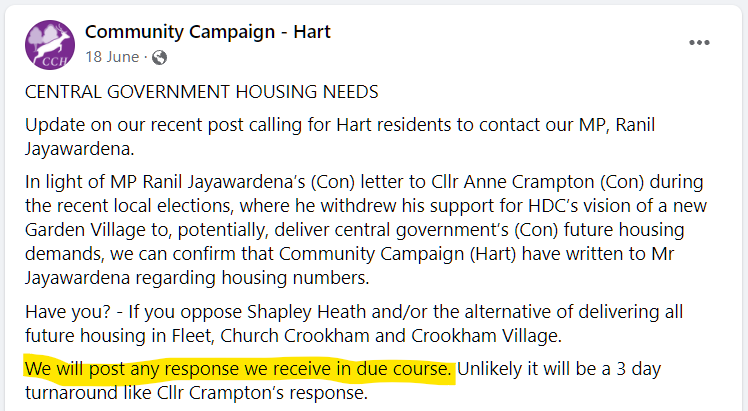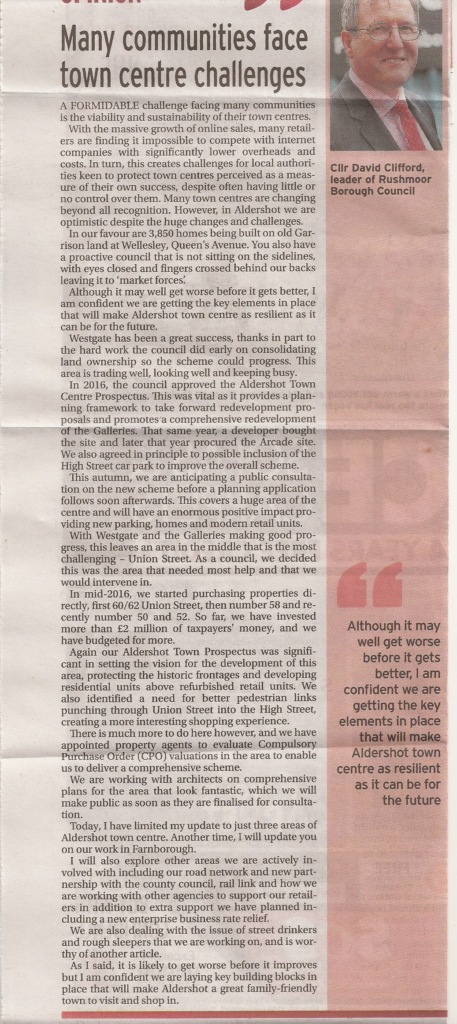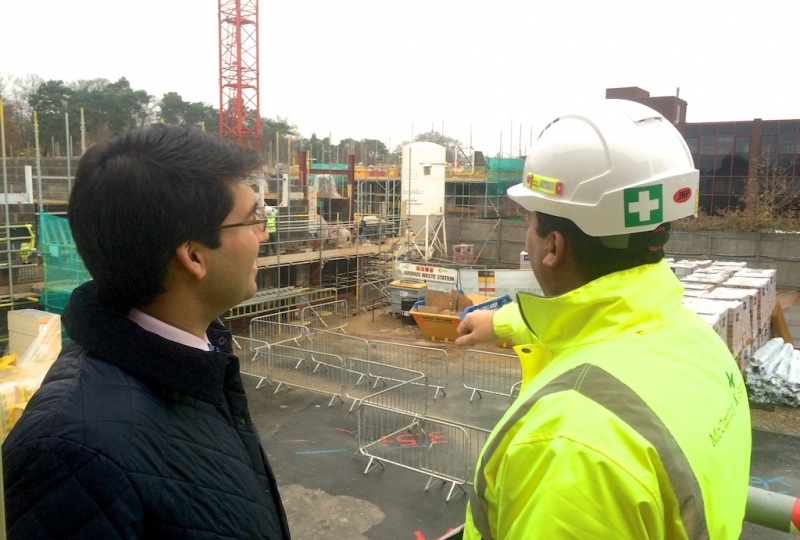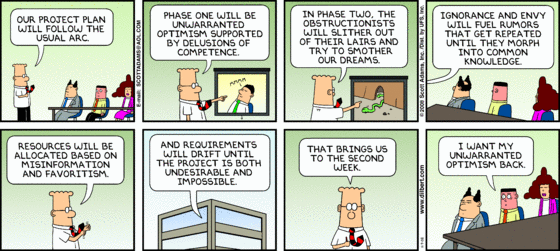Local political party, Completely Concrete Community Campaign Hart (CCH) have been sent into disarray after our local MP, Ranil Jayawardena took them to task over their lack of a regeneration strategy.
Origins of the CCH They Don’t Like it Up Em Saga
Back in the summer, CCH published a post on their Facebook page saying they had written to our MP to ask about Hart’s housing numbers. They promised to “post any response we receive in due course”.
Months passed and CCH went very quiet. A number of people asked politely what had happened to the response. Eventually it came to light that Ranil had answered their letter but CCH was reneging on their promise to publish it. Apparently, Ranil had not answered their question in the way they wanted. Apparently, CCH can renege on promises if things don’t go their way.
Follow Up from Concerned Resident
We understand that a concerned resident contacted Ranil with what they thought were similar questions. Recently the, resident received a reply (shown in full below) that took CCH to task. Ranil felt CCH were “passing the buck” and not getting on with the job they were elected to do. He also lamented their focus on buying up office buildings outside of the district. He was clearly disappointed that CCH are focused on the ill-fated Shapley Heath green field project to deliver more houses than are actually needed. He pointed out that CCH and the Lib Dems are not showing any leadership around regeneration of our urban centres.
The post related to this response from Ranil can be found here.
Response from CCH – They Don’t Like it Up Em
This has prompted a childish response from CCH, accusing We Heart Hart of being “Facebook collaborators”, whatever that means. We had no involvement in the letter to or response from Ranil.
They gave a long diatribe about the Brownfield Register, which mostly contains sites that have planning permission, some of which have already been built. Indeed there’s 3,600-3,800 homes identified compared to the meagre 400 we were told were possible in 2015. It is clear the council systematically underestimates the brownfield capacity of the district.
The Civic Quarter is conspicuously missing from the Brownfield register. This site is in public ownership and Hart have been trying to pull together a plan for its regeneration for at least two years. Like with the Shapley Heath project, they have delivered nothing. If the Council can’t even be bothered to put its own land on the brownfield register, what hope is there to persuade developers that they are serious about regeneration?
They also stated that the Hart Shopping Centre was not available for regeneration. This is clearly nonsense. We helped publicise a potential scheme back in 2018. This could have delivered hundreds of new homes and cultural facilities, without a penny of public money. The reason the project has not moved forward is that nobody from Hart Council would meet with representatives of the owners. Again, if the Council won’t take the initiative when an opportunity is presented to them on a plate, then they won’t get anywhere.
It seems CCH want to blame everyone else and not take the initiative to get things done. They are an empty vessel that makes a lot of noise, but lacks any real substance.
CCH They Don’t Like it Up Em – Letter from Ranil
I do not believe that CCH’s ongoing public ‘to and fro’ is in the public interest. Rather, many residents have said that they believe it is an attempt by CCH to ‘pass the buck’ from getting on with the job that they have – for now – been elected to do. The interests of my constituents are not best served through seeking to distort the truth, nor making potentially slanderous comments in public meetings.
My views remain the same. I support my constituents when they tell me that they want to see the development and regeneration of brownfield land first. Planning decisions remain for local councils and it is for Hart District Council (HDC) – which is ruled by CCH and their Lib Dem collaborators – to actually take forward the work needed to assess and procure brownfield land.
CCH have contacted me to ask what brownfield land is available. This is a complete abdication of responsibility. My response to them is very clear – I have my own views, I have delivered regeneration elsewhere; I know that councils have all the powers they need to get on with the job, but this is about leadership. They control the council so, if they are serious about brownfield regeneration, it is important for them to be bold in identifying what brownfield land they would like to acquire for development, whether or not it is on the open market currently. That is why I continue to call for HDC to carry out this work, rather than asking me to do their job for them without the resources of a council behind me.
In seeking to be as helpful as possible, it is not always understood that councils are able to buy land and buildings that are not for sale, through Compulsory Purchase Orders (CPOs). This can and, in my opinion should, be a key part of a robust focus on brownfield regeneration in our area, to improve the look and feel of Fleet’s, Yateley’s and Hook’s retail centres. This way forward relies on the council demonstrating flexibility and ambition – they must be ready to buy today to regenerate tomorrow.
Extraordinarily, whilst local people want the council to invest in our local area – to deliver brownfield regeneration – I am given to understand the CCH/LibDem rulers of HDC are buying buildings in Basingstoke and in the south of Hampshire instead. Why, I do not know, and this is a great shame because this money could have been used locally to begin to turn our retail centres around.
Again, this is about leadership. Only a robust approach will protect the environment surrounding our communities and – whilst it is not for me, nor HM Government, to carry out these studies – many constituents have asked that I continue to urge HDC to do this work and to get them to get on with brownfield regeneration, rather than pursuing their current plans to concrete over a huge number of green fields to build inflated housing numbers.
For the avoidance of doubt, I refer to HDC building an inflated number of houses – despite what I can only conclude is an attempt at political posturing from CCH – because it is they who decided to include 423 new dwellings per year in their local plan. This is far more than was needed, evidence by HM Government’s indicative new homes target for Hart of just 286 per year – 137 new homes a year fewer than those in charge of HDC have decided to build.
I will always champion the best interests of North East Hampshire and I am pleased that the Prime Minister agrees with the approach I have long set out – most recently in in my Constituency Conservation Charter at: ranil.uk/charter – as he recently confirmed that there should not be major developments on green fields. Instead he wants the focus to be on brownfield sites. On 6th October he said:
“You can… see how much room there is to build the homes that young families need in this country… not on green fields, not just jammed in the South East, but beautiful homes on brownfield sites in places where homes make sense.”
I would urge any local resident who has not yet signed my Constituency Conservation Charter to do so urgently, in order that I will have a stronger evidence base to use in making the case for this to HDC.
And that is the truth: whatever I or the Prime Minister think, whatever we would like to see, we create the national policy; we do not decide planning applications nor do we set the Local Plan. The clue is in the name of the latter. Local democracy means that it is for our local council to now get on with it, to provide leadership and to deliver what local people and I are calling for. CCH and the Lib Dems no longer have any excuse.
I hope this provides a helpful update on my position.














































